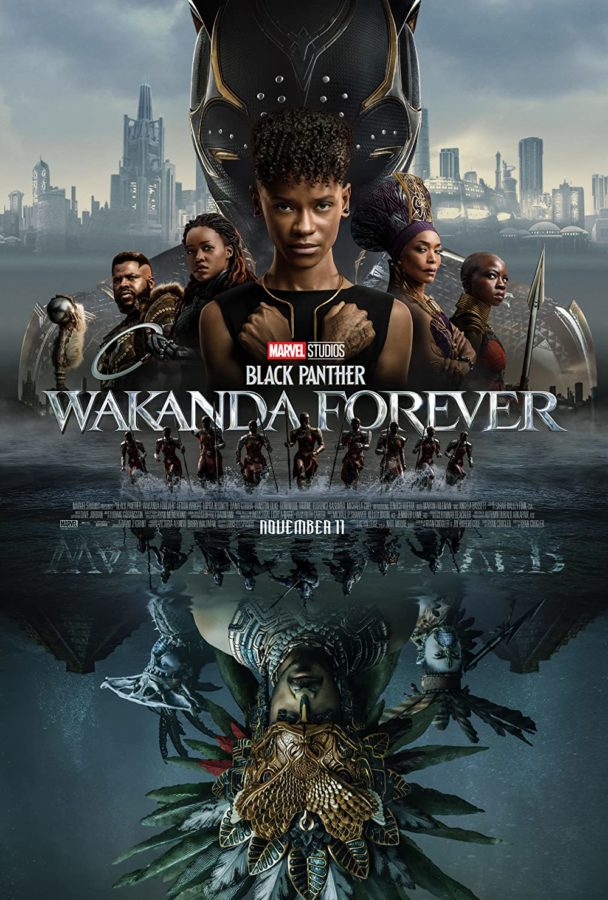Black Panther: Wakanda Forever Review
“Black Panther: Wakanda Forever” released Nov. 11, 2022, is the sequel to original “Black Panther” from Feb. 16, 2018. The first movie left watchers with a cliffhanger of the Wakandans revealing their hidden vibranium, one of the strongest metals in the Marvel Cinematic Universe and the key to Wakanda’s extreme advance in technology, to the world in a United Nations conference meeting which appears as a common setting throughout both films. A great deal has changed since the first film, the biggest and most unfortunate being the death of actor Chadwick Boseman on Aug. 28, 2020. Boseman, playing the lead role of King T’Challa, led Marvel to continue their path of extending the multiverse to make up for his loss.
The focus of the movie wasn’t only to continue on the story of Wakanda, but also as a tribute to Boseman, including multiple moments to remember and honor him. T’Challa’s funeral was held in the beginning of the film capturing the grief of everyone, but especially his mother, Queen Ramonda, and younger sister, Princess Shuri. Wakanda, which seemed weak and vulnerable, was a target of other nations attempting to manipulate them, but with Shuri’s scientific abilities, Ramonda’s secure leadership, and the other Wakandan nations coming together in support, the U.S. and France pose no threat against them, despite their continuous scheming behind the backs of Wakanda.
These conspiring acts lead to the reveal of the main antagonist, the nation of Talokan and their leader Namor. Namor is a mutant with abilities to fly, survive in and out of water, slow aging, and his access to vibranium gives him advantages in which one would not want to be made enemies with. The rising action of the story starts with Namor taking capture of Shuri and American scientist, Riri, and insisting that Shuri make a decision on behalf of Wakanda between becoming allies, or enemies with Namor and his people. This point in the plot is where it starts to get cluttered as there are scenes that start switching between the different interactions. Some examples are Shuri and the added character of the scientist with Namor, Agent Ross, back in America negotiating terms with the Central Intelligence Agency, and soldier Okoye with new character Aneka. Michael B. Jordan makes a surprising reappearance as Kilmonger once Shuri decides to continue the culture and become the Black Panther after Namor kills her mother Ramonda. Seeing Kilmonger gives the sequel the same unexpected elements that were shown in the first “Black Panther” as Shuri comes face to face with this new responsibility and pressure.
The climax and falling action take place during the war between the Talokan and Wakandans in which Shuri makes the internal decision of sparing Namor’s life, even after everything he did to her, after their one on one battle. This gives the Wakandans peace, however near the end of the film, it is shown that after owing Shuri his life, Namor still is not finished with Wakanda and plans to wait for his time to shine once again. The movie ends with another tribute to Boseman, with Shuri finally accepting his death with his love interest, Nakia, revealing their child who was named after his father. The song “Lift Me Up” by Rihanna, plays during this touching scene as the film shows that this is not the end of Wakanda and the Black Panther.
Overall, “Wakanda Forever” seemed like more of a transition movie between the old and upcoming plot, but its main purpose was honoring Boseman. They also added onto the subject of feminism. Although it was very enjoyable and moved many to tears, the sequel did not compare to the original not only with the plot, but with the soundtrack. Again, it is understandable that the songs chosen were meant to be heartwarming, however the 2018 film had more hits especially with the ending song, “All the Stars,” with Kendrick Lamar and SZA. Nevertheless, it gave a strong message and was a true gift to watch.



